MOSFET
Introduction¶
MOSFETs are types of Field effect transistors (FETs) where the control terminal is isolated using an oxide layer.
FETs are those transistors where an electric field is used to control the conduction of electricity through a semiconductor. FETs are different from BJTs because in BJTs barrier voltage is lowered and thermal energy causes the charge carriers to flow. In FETs, an electric field enhances or deplete the charge carrier density in the conduction path.
Now processes with both NMOS and PMOS are available. We call these process as Complementary MOSFETs (CMOS).
General properties of MOSFET¶
Major advantages :
- They are very compact and very scalable.
- Very high input impedance (DC input impedance in infinite).
- Complementry MOSFETs (CMOS) consume zero static current in digital circuits.
- Very small MOSFETs offers very high speeds.
Comparision against BJT¶
MOSFETs are better than BJTs because :
- MOSFETs can be very compact which makes them more suitable for digital logic. BJT's minimum size can still be much higher than MOSFETs.
- CMOS don't dissipate any static current while BJT dissipates a static current in digital circuits.
- Since CMOS can be smaller, the speed achieved can be much higher than BJT.
MOSFETs are not preferred over BJTs when :
- High frequency as well as high current drive is required.
- Very high precision at low frequency is required. This is because BJTs have very low flicker noise and have better matching for the same area.
- Due to the presence of Gate oxide (which can permanently break down), MOSFETs don't offer as good reliability as BJTs.
Principle of operation¶
In MOSFET, the conduction between 2 terminals (Drain and Source) is controlled through a voltage applied to another terminal (Gate).
We shall first understand enhancement type N-channel :
The source and drain is doped with n-type material. In-between the source and drain terminal, there exist the body (possible channel area) which is p-type doped.
If Gate voltage is zero, and drain-source voltage is positive, then it is just a reverse-bias diode which conducts negligible current.
If Gate voltage is positive, this creates a electric field across the channel. This pushes the holes out of the channel area and attracts any free electrons from other parts of the body to the channel area. The conduction starts but the current is still very low because there are not sufficient electrons in the channel area. If the voltage is made higher than the threshold voltage (VT), then we remove all the holes from the channel and replace them with sufficient electrons. This replacement of holes with electrons in the channel area is called inversion.
Terminals¶
Like any FET, MOSFET also have 4 terminals :
- Gate
- Drain
- Source
- Bulk
Gate control the electric field in the channel which enhances or deplete the conduction in the conduction channel.
Source terminal is the terminal from where the majority charge carriers enters the conduction channel. The source terminal is one of the 2 terminals across the conduction.
Drain terminal is the terminal from where the majority charge carriers exit the conduction channel. The drain is the other of the 2 terminals across the conduction channel.
Bulk terminal is used as a reference terminal. Usually it is tied with the source terminal.
Symbols¶
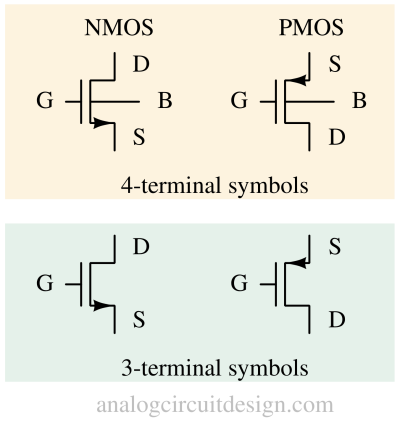
Types¶
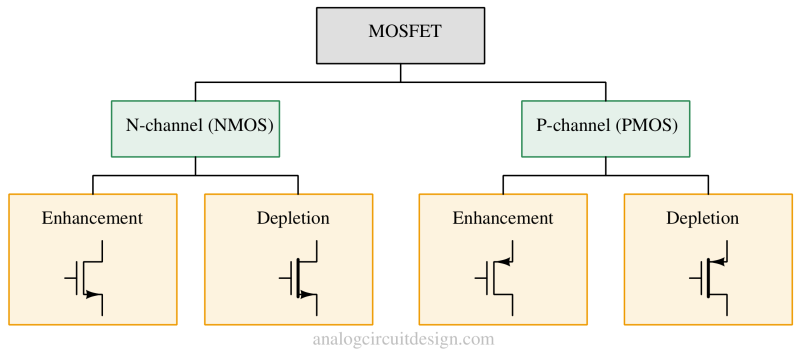
- N-channel (NMOS) - The channel formed between the source and drain is of N-type after inversion in the body. The body is made of P-type material. To learn more about NMOS, please visit this page: N-Channel MOSFET (NMOS)
- P-channel (PMOS) - The channel formed between the source and drain is of P-type after inversion in the body. The body is made of N-type material. To learn more about NMOS, please visit this page: P-Channel MOSFET (PMOS)
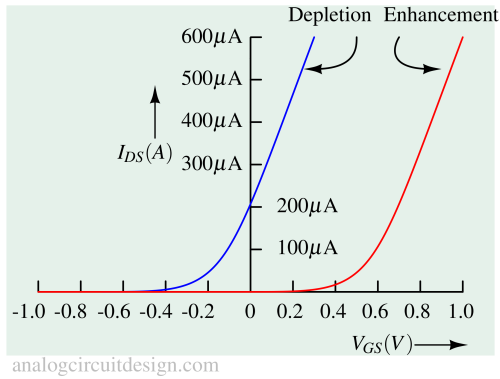
- Enhancement device - When VGS is zero then there is no channel in the device. So, it is in cutoff mode by default. For n-channel devices, the threshold voltage is positive.
- Depletion device - When VGS is zero, there is still a channel present in the device and the the device can conduct. It requires negative VGS to remove the channel and turn-off the device. For n-channel devices, the threshold voltage is negative.
Construction of MOSFET¶
N-channel MOSFET¶
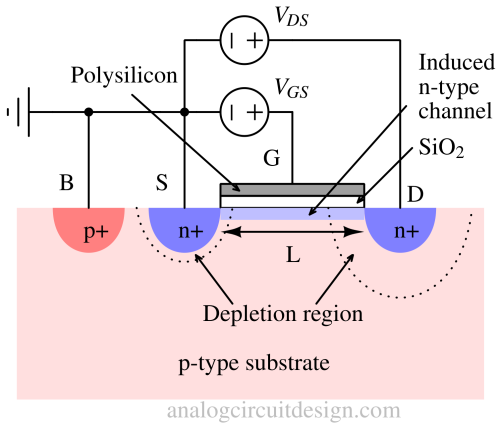
P-channel MOSFET¶
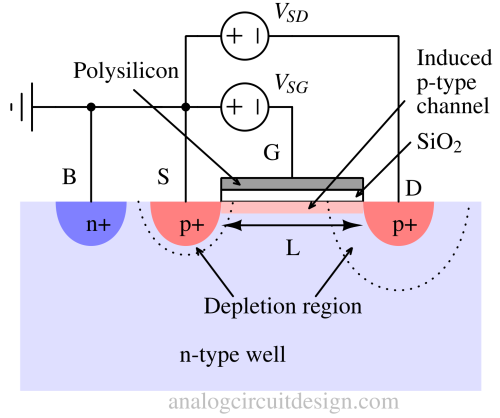
Regions of operation¶

Cutoff region¶
In this region, drain-source current is zero or negligible. Usually, N-channel devices, if VGS < VT then transistor is in cut-off region. For P-channel device, if VSG < VT then transistor is in cut-off region.
$$I_{DS} = 0$$
Linear (or triode) region¶
In this region, MOSFET act as a variable resistor.
$$I_{DS} = \cfrac{\mu{}C_{ox}W}{L}\left[\left(V_{GS}-V_T\right)V_{DS}-\cfrac{V_{DS}^2}{2}\right]$$
Pinch-off (or saturation) region¶
In this region, the MOSFET act as voltage controlled current source. The gate terminal is used to provide the voltage. The drain terminal is used as a current source.
If VDS>VGS-VT, then the transistor is in pinch-off region. In this region, reasonable voltage swing at the drain terminal does not change the current of the drain terminal.
$$I_{DS} = \cfrac{\mu{}C_{ox}W}{2L}\left(V_{GS}-V_T\right)^2$$
The above equation suggest that the output current is totally independent of output voltage. However, in reality it is not the case. The output current slightly depends on the output voltage i.e., VDS. The influence of drain-source voltage on the drain current is called channel length modulation. If we want the consider the channel length modulation due to VDS then we can use the following equation:
$$I_{DS} = \cfrac{\mu{}C_{ox}W}{2L}\left(V_{GS}-V_T\right)^2\left(1+\lambda{}V_{DS}\right)$$
MOSFET as a switch¶
In this region, MOSFET is either in linear region or cutoff region. Since MOSFETs have infinite input resistance, these are very ideal for switching applications.
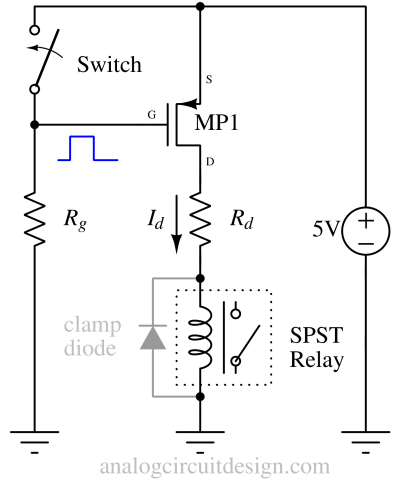
MOSFET as an amplifier¶

In this region, MOSFET is biased in pinch-off region. It is also called active region.
Summary¶
Most popular MOSFETs are enhancement devices (N-channel and P-channel). Usually these are called NMOS and PMOS respectively without mentioning that these are enhancement devices.
In next article we will look into PMOS and NMOS individually.